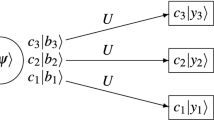Abstract
In a previous paper, a statistical method of constructing quantum models of classical properties has been described. The present paper concludes the description by turning to classical mechanics. The quantum states that maximize entropy for given averages and variances of coordinates and momenta are called ME packets. They generalize the Gaussian wave packets. A non-trivial extension of the partition-function method of probability calculus to quantum mechanics is given. Non-commutativity of quantum variables limits its usefulness. Still, the general form of the state operators of ME packets is obtained with its help. The diagonal representation of the operators is found. A general way of calculating averages that can replace the partition function method is described. Classical mechanics is reinterpreted as a statistical theory. Classical trajectories are replaced by classical ME packets. Quantum states approximate classical ones if the product of the coordinate and momentum variances is much larger than Planck constant. Thus, ME packets with large variances follow their classical counterparts better than Gaussian wave packets.
Similar content being viewed by others
References
Zurek, W.H.: Rev. Mod. Phys. 75, 715 (2003)
Giulini, D., Joos, E., Kiefer, C., Kupsch, J., Stamatescu, I.-O., Zeh, H.D.: Decoherence and the Appearance of Classical World in Quantum Theory. Springer, Berlin (1996)
Bub, J.: Interpreting the Quantum World. Cambridge University Press, Cambridge (1997)
Hájíček, P., Tolar, J.: Intrinsic properties of quantum systems, arXiv:0806.4437
d’Espagnat, B.: Veiled Reality. Addison-Wesley, Reading (1995)
Peres, A.: Quantum Theory: Concepts and Methods. Kluwer Academic, Dordrecht (1995)
Poulin, D.: Phys. Rev. A 71, 022102 (2005)
Kofler, J., Brukner, Č.: Phys. Rev. Lett. 99, 180403 (2007)
Hepp, K.: Helv. Phys. Acta 45, 237 (1972)
Bell, J.S.: Helv. Phys. Acta 48, 93 (1975)
Bóna, P.: Acta Phys. Slov. 23, 149 (1973)
Bóna, P.: Acta Phys. Slov. 25, 3 (1975)
Bóna, P.: Acta Phys. Slov. 27, 101 (1977)
Sewell, G.L.: Quantum Mechanics and its Emergent Macrophysics. Princeton University Press, Princeton (2002)
Primas, H.: Asymptotically disjoint quantum states. In: Blanchard, Ph. (eds.) Decoherence: Theoretical, Experimental, and Conceptual Problems. LNP, vol. 538. Springer, Berlin (2002)
Bell, J.S.: Against ’measurement’. In: Miller, A.I. (ed.) Sixty Two Years of Uncertainty. Plenum, New York (1990)
Wallace, D.: The quantum measurement problem: state of play, arXiv:0712.0149v1 [quant-ph]
Gemmer, J., Michel, M., Mahler, G.: Quantum Thermodynamics. Emergence of Thermodynamic Behaviour Within Composite Quantum Systems. LNP, vol. 657. Springer, Berlin (2004)
Linden, N., et al.: Quantum mechanical evolution towards thermal equilibrium, arXiv:0812.2385
Goldstein, S., : Phys. Rev. Lett. 96, 050403 (2006)
Isham, C.J.: Lectures on Quantum Theory. Mathematical and Structural Foundations. Imperial College Press, London (1995)
Jaynes, E.T.: Probability Theory. The Logic of Science. Cambridge University Press, Cambridge (2003)
von Neumann, J.: Mathematical Foundation of Quantum Mechanics. Princeton University Press, Princeton (1983)
Ballentine, L.E.: Quantum Mechanics. A Modern Development. World Scientific, Singapore (2008)
Author information
Authors and Affiliations
Corresponding author
Rights and permissions
About this article
Cite this article
Hájíček, P. Quantum Model of Classical Mechanics: Maximum Entropy Packets. Found Phys 39, 1072–1096 (2009). https://doi.org/10.1007/s10701-009-9318-5
Received:
Accepted:
Published:
Issue Date:
DOI: https://doi.org/10.1007/s10701-009-9318-5




